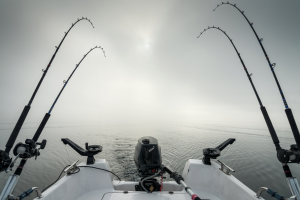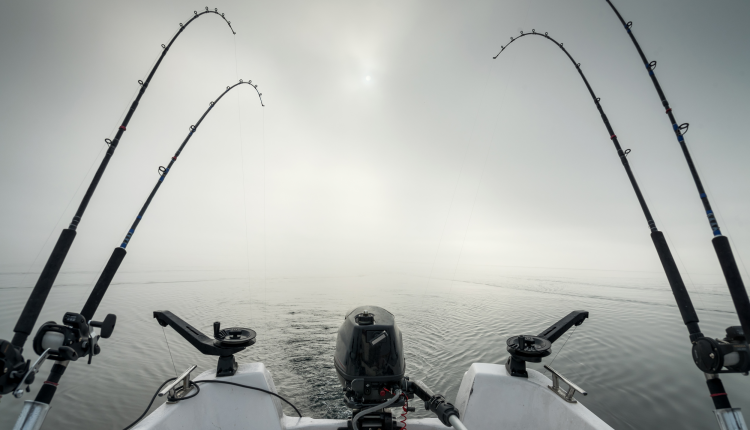Freshwater Trolling Fishing Basics
Freshwater fish are fish that spend all or some of their lives in freshwater, like lakes, stream, and rivers, with a salinity of less than .05 percent. These fishes make up about 42 percent of all known fish species in the world. Freshwater fish have been a part of the human diet for thousands of years. Freshwater species include trout, crappie, largemouth bass, northern pike, catfish, walleye and Kokanee. One thing these fish all have in common is the effective technique fishermen fish them, and that is the trolling method.
 Trolling is a fishing technique in which baits or lures are dragged behind a boat at different depths and speeds according to the habitat, nature, and size of the fish being hunt. Trolling is practiced both in saltwater and freshwater with all types of craft; Motorboats that carry different equipment and big-game tackle are often used at sea, and can as well be used on inland waters, where it is legal. This fishing method allows fishermen to cover a wide area, which makes it the most preferred method among sport fishermen in search of highly mobile species like muskellunge and walleye in big freshwater lakes and rivers.
Trolling is a fishing technique in which baits or lures are dragged behind a boat at different depths and speeds according to the habitat, nature, and size of the fish being hunt. Trolling is practiced both in saltwater and freshwater with all types of craft; Motorboats that carry different equipment and big-game tackle are often used at sea, and can as well be used on inland waters, where it is legal. This fishing method allows fishermen to cover a wide area, which makes it the most preferred method among sport fishermen in search of highly mobile species like muskellunge and walleye in big freshwater lakes and rivers.
Trolling technique is very useful in freshwater. It is synonymous with sport fishing but can be effective for hunting different fish of all sizes and in all depths of the water. Technological developments in navigation aids, boating equipment, water temperatures gauges, deep sounders, including tackle used by fishermen have increased the number of freshwater trolling anglers who enjoy trolling these amazing creatures.

Freshwater Troll Fishing can be done with live or dead baits and lures. The combination of bait and lure has been developed over the years in which a skirt of a feather can be decorated with the head of the bait. This can serve two purposes, attract the attention of the fish and also extends the life of the bait. While the bait is pulled through the water, the skirt breaks the water ahead of the baitfish and reduces the amount of friction on the bait, which provides a streamlined and faster-trolling action. This action thrills the fish and encourages a bite at the moving bait.

Crankbaits and floating plugs are the easiest way to start freshwater trolling and are also the perfect baits to pull. Although on a steady troll, most lipped plugs have a good swimming action. But floating baits are the best choice, as they will float to the surface instead of sinking to the bottom and getting snagged if the boat is taken out of gear for any reason. If you are a novice to this method, choose the depth of water you think is holding in, place a few baits out behind the boat and then try to hit several water structures and cover types as possible.
Types of Freshwater Troll Fishing
Most of the time in freshwater, fish that were concentrated near the surface have gone deeper and spread widely. And the only method that can present different kinds of lures at such a variety of depths is trolling method. However, there is more to trolling than just dragging bait after a boat, different kinds of trolling methods targeted specific kinds of fish can radically improve your catch. The following are different ways to troll freshwater.
-
Check out on Amazon: Manual Downrigger Down rigging: Trolling with downriggers can get your lures or baits deeper than other techniques. In extreme cases, the depth can be as deep as a few hundred feet, but the most common is 30 to 60 feet. This is also a great light-tackle method because when a fish bites, the line pops out of the release clip next to the trolling weight so that the fight continues unfettered by heavy tackle.
-
Check out on Amazon: Krazywolf Planer Boards Left and Right with Tattler Planer Boards technique: This is the most effective trolling method, however, they are a bit difficult to use. These 7 to 12 inches floating “boards” hold your line between 50 and 100 feet from the side of the boat. This set a pair of planers, one on each side, which means you are covering a swath of water up to 200 meters in diameter and, therefore, you are more likely to come across fish. And because the lines and lures are far from your droning outboard, you are less likely to spook fish.
- Flat-lining: With this trolling technique, your line is directly connected to a lure without any secondary device or weight added. It is generally seen as a near-surface method, the flat-lining allows you to get to the moderate depths by trolling deep diving crankbaits or jigs.
Freshwater Troll Fishing Tips
Freshwater Troll Fishing is the best method for landing numbers of walleye in the boat. The trolling method allows you to effectively cover a large area of freshwater in a day and easily detect productive spots. Although this fishing method is so simple at its basic level, it requires coordination, skill, and practice to constantly land fish under the constant changing conditions that fishermen face. So if you enjoy freshwater troll fishing, the following tips can help you troll more effectively and improve your catch.
-
Check out on Amazon: Tidewater Trolling Combo Get the right Tackle: Freshwater trolling is one of the most tackle specific fishing methods and having the right reels, lines, and rods will make a big difference. Most trolling rods are long, about 7 to 9 feet and with forgiving tapers. And having bait casting reels and line counters will help you control how much fishing line is out; planer boards will also increase the width of your trolling space. Fortunately, the trolling equipment is not too expensive; you can get quality lines, rods, and reels within your budget.
- Have a plan: When it comes to freshwater troll fishing, you need a plan, especially when casting. You don’t just launch your boat to the nearest bank and start casting. It is important to know the right lures to use, study the map and have a strategy before you hit the water. The right places to start are break lines, creek or river channels, stumpy flats, and points. Choose a route on the map and stick to it when fishing.





Best Freshwater Fishing When to Freshwater Fish Freshwater Bait and Lures Learn About Freshwater Fish Species Best Freshwater Fishing Gear Freshwater Fishing FAQ View All